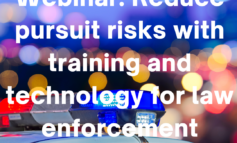By Melissa Mann

NYPD squad car speeds down the street.
The high-speed pursuit of a fleeing suspect presents a substantial danger to the lives of officers, suspects and the public. The 2010 FBI Law Enforcement Bulletin indicates that one life is lost each day due to police pursuits. Additionally, the bulletin noted that 42 percent of those fatalities were people who were bystanders, uninvolved in the pursuit.
The decision to fire up the lights and siren is one that should never be taken lightly by an officer. Most agencies consider pursuit a use of force, and appropriate justification must be made before it is initiated. Because of the danger involved, officers and police administrators must actively take steps to reduce the inherent risks involved in each pursuit. The following five tips will help officers protect themselves, their suspects and bystanders.
1. Know your agency’s pursuit policy
Know your agency’s pursuit policy inside and out. Many recent policy changes in states across the country limit the authority to initiate pursuits. In some areas, highway patrol officers have been restricted to pursuing only criminals suspected of specific crimes: violent felonies, reckless driving and suspected drunk drivers.
Others limit this even further. The Milwaukee Police Department has instituted a no-pursuit policy unless the suspect has specifically committed a violent felony.
Knowing when to engage and disengage from a pursuit will serve as a protection for both you and your agency.
2. Maintain situational awareness
Your own safety and the safety of others is reliant upon you recognizing your surroundings and being aware of your environment. This includes road conditions, the presence of pedestrians and the level of traffic congestion, as well as other factors related to inclement weather.
Familiarity with your geographical patrol area, the terrain and your exact direction of travel are necessities for you and a benefit to others, especially your secondary unit and incident dispatcher.
3. Tune out distractions
Unfortunately, the rest of the world won’t stop when a pursuit begins. You must practice prioritizing all of the voices and bells calling for your attention during your pursuit.
A typically overlooked factor that officers deal with during pursuits is the number of electronic devices competing for your attention inside the squad car. With your Mobile Digital Communicator (MDC) ringing for each added detail, your cell phone chirping and your dispatcher calling your identifier for an update, keep calm and prioritize which call you need to answer first.
4. Remember to breathe
Don’t forget to breathe. Although this seems simple, make sure to take a deep breath. This practice will help you maintain a balanced perspective while under distress.
This is where your “combat breathing” will pay off. A deep breath in followed by a slow release will help keep you clearly engaged and free of emotion so you are able to manage the stress of a high-speed pursuit. Conscious awareness of your breathing will enhance your performance while you are engaged in one of the most dangerous patrol situations.
5. Continue to evaluate the situation throughout the pursuit
Just because a pursuit has been initiated doesn’t mean it cannot also be called off. The officer who engages in the vehicular pursuit must constantly evaluate the risks and rewards of the pursuit and determine whether it is worthwhile to continue – or if it’s time to throw in the towel. The situation will evolve from moment to moment and requires you to keep up.
Keep these tips in mind to help ensure the safety of everyone involved: yourself, other officers, the public and the suspect. Self-awareness while under stress will help you keep your head fully in the game so everyone can go home safe at the end of the day.




